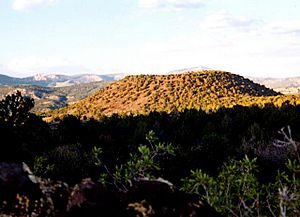Bald Knoll facts for kids
Quick facts for kids Bald Knoll |
|
|---|---|

Bald Knoll is the youngest of a group of cinder cones on the SW part of the Paunsaugunt Plateau in southern Utah.
|
|
| Highest point | |
| Elevation | 7,003 ft (2,135 m) |
| Geology | |
| Mountain type | Cinder cone |
| Last eruption | Unknown |
Bald Knoll, also called Black Knoll, Buck Knoll, or Corral Knoll, is a special type of volcano known as a cinder cone. It is found in Utah, a state in the Southwestern United States.
This volcano is the youngest in a group of cinder cones located on the southwest part of the Paunsaugunt Plateau. Bald Knoll is made of a type of volcanic rock called basaltic lava. It has a very clear and well-preserved volcanic crater at its very top.
Contents
What is Bald Knoll?
Bald Knoll is a fascinating natural landmark. It stands tall at 7,003 feet (2,135 meters) above sea level. This makes it a noticeable feature in the landscape of southern Utah.
A Young Volcano
Bald Knoll is considered the newest volcano in its area. It formed on the southwestern edge of the Paunsaugunt Plateau. This plateau is a large, flat-topped area of land.
What is a Cinder Cone?
A cinder cone is the simplest type of volcano. It is shaped like a cone or a hill. Cinder cones are built from small pieces of lava. These pieces are called cinders or scoria.
- When a volcano erupts, hot lava shoots into the air.
- As the lava cools, it breaks into small, bubbly pieces.
- These pieces fall back down around the volcanic vent.
- Over time, they pile up to form the cone shape.
- The top of a cinder cone usually has a bowl-shaped crater. This is where the lava came out.
Basaltic Lava
Bald Knoll is made of basaltic lava. Basalt is a common type of volcanic rock. It is usually dark in color. When basalt lava erupts, it is often very fluid. This means it flows easily.
- Basaltic lava flows can travel long distances.
- They create wide, flat layers of rock.
- The cinders that form cinder cones are also made of basalt.
The Volcanic Crater
At the very top of Bald Knoll, you can see a clear volcanic crater. This is a bowl-shaped hollow. It was formed during the volcano's eruption. The crater is where the volcanic materials were ejected.
- Craters are often found at the summit of volcanoes.
- They can vary in size and shape.
- Bald Knoll's crater is well-preserved. This means it still looks much like it did after its last eruption.
Where is Bald Knoll Located?
Bald Knoll is found in Kane County, Utah. This area is part of the Basin and Range Province. The Basin and Range Province is a large region in the western United States. It is known for its many mountain ranges and valleys.
- The region has been shaped by stretching and faulting of the Earth's crust.
- This geological activity can lead to volcanic eruptions.
- Bald Knoll is a good example of the volcanic features in this area.
The Paunsaugunt Plateau
The Paunsaugunt Plateau is a high plateau in southern Utah. It is famous for its beautiful red rock formations. These include places like Bryce Canyon National Park.
- Bald Knoll sits on the southwestern edge of this plateau.
- Its location offers great views of the surrounding landscape.
- The plateau itself was formed by uplift and erosion over millions of years.
Last Eruption
The exact date of Bald Knoll's last eruption is unknown. However, because it is the youngest volcano in its group and has a well-preserved crater, scientists know it erupted relatively recently in geological time. This means it's not an ancient, heavily eroded volcano.
Exploring Bald Knoll
While Bald Knoll is a volcano, it is not currently active. It is a place where people can explore and learn about geology. The area around Bald Knoll is part of a beautiful natural landscape.
- Visitors can observe the unique shape of the cinder cone.
- They can also see the basaltic rocks that make up the volcano.
- It's a great spot to understand how volcanoes shape the Earth.

